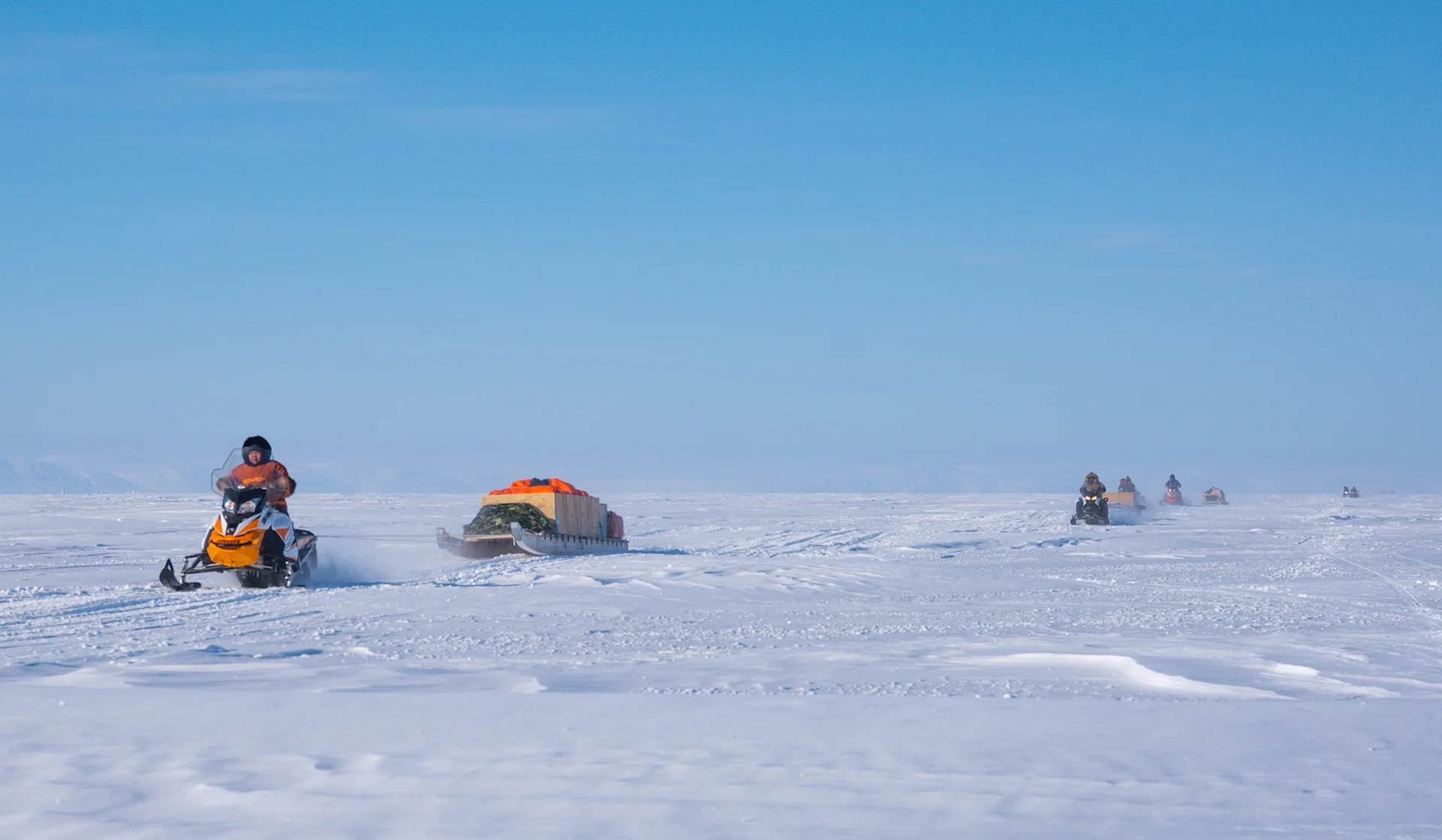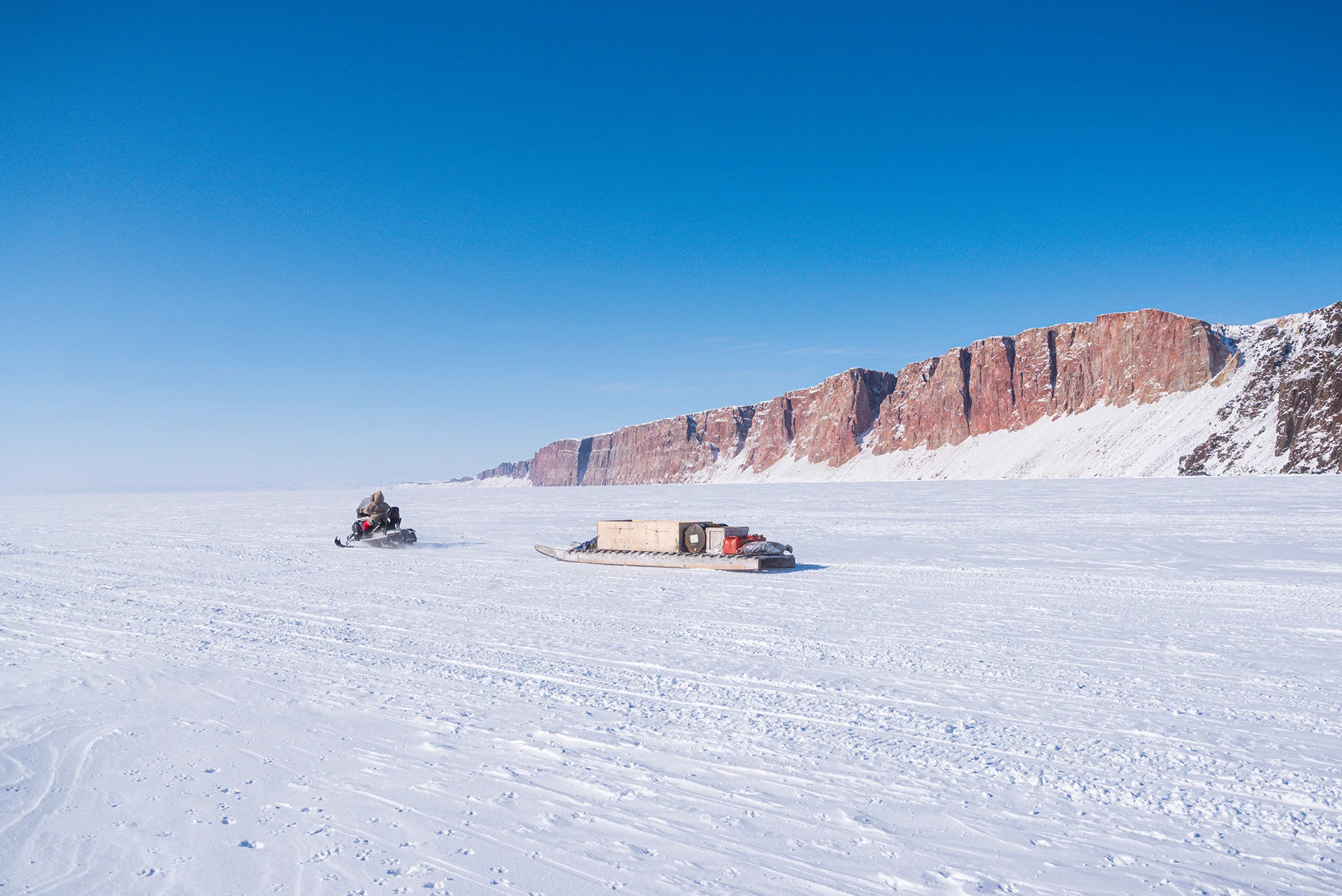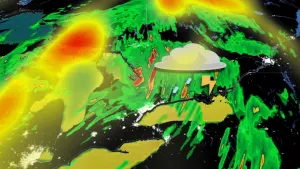
Solutions for navigating shifting trails in the Canadian Arctic
Niore Iqalukjuak has seen the land, water, and weather change over the years around Arctic Bay in Nunavut, the fourth most northerly community in Canada.
“There’s a lot of land where you can see mudslides from the permafrost melting,” he told The Weather Network about the changes seen recently to the small community — one of the northernmost Inuit settlements in the Arctic — of roughly 800 people.
“In the wintertime, it seems, even though it's very cold, the wind travels from the south to north so around Lancaster Sound, the ice hasn’t really frozen — it’s still warm.”
A community supervisor with the Nauttiqsuqtiit guardians program, which first launched in 2018, much of Iqalukjuak’s work involves spending time out on the land, monitoring the ice, and helping harvest food for the community.
Most residents there rely on stable ice and weather conditions to engage in traditional living that involves hunting, travelling between communities, and spending time on the land. They also rely on intricate networks of community trails that help keep them connected in an otherwise vast and isolated landscape.
But the changing climate is challenging this way of life for Inuit, like Iqalukjuak, because it causes safety concerns, limits food harvesting, and even strains the process of keeping their culture alive.
Even as technology evolves, and is used to go out on trails, other challenges emerge. There is limited knowledge of trail conditions versus trail routes, and the digital divide across generations doesn’t help. The passing of knowledge through oral tradition and lived experience, as has been done across millennia by Inuit, isn’t always captured by new tech.
Iqalukjuak is not alone in his experience. Research recently published in the science journal Nature shows that access to the outdoors — especially through trails — is in decline.
As human activity, such as burning fossil fuels, continues to warm the planet, Inuit are increasingly faced with the question of how they will access their territory.

Researching trails with local users in Inuit Nunangat. (Dylan Clark)
Behind the research
James D. Ford has been working with Inuit communities in Canada for over a decade now.
A chair in Climate Change Adaptation at the Priestley International Centre for Climate at the University of Leeds, his research across the Arctic covers health and well-being, food security, wildfires, and even resource management in the region.
As one of the authors of the Nature research mentioned earlier, he says the published findings provide quantitative data for the first time about how access to trails may decline across the entire Inuit Nunangat region over the next 80 years.
READ MORE: Arctic transforming into ‘dramatically different state’ due to climate change
“Up until we started working on this trail modelling our work was more qualitative in nature — doing interviews, focus groups, spending time in communities and documenting experiences,” he told The Weather Network. Based on interviews with more than 270 trail users across communities and climate data such as sea-ice projections from Nunavut, Nunavik, Inuvialuit, and Nunatsiavut in Newfoundland and Labrador, Ford and his team established more quantitative data to discover there are currently 249 days each year when land, sea, and ice trails are accessible.
That number could decrease to about 236 days per year by 2050, and as low as 209 days per year by 2100.
To address this decline, Ford suggests focusing on four key strategies: passing down knowledge, mapping the change, integrating technology and building observational skills.

Travelling via snowmobile across Inuit Nunangat in Northern Canada. (Dustin Patar)
Passing down knowledge
As trail access declines, researchers say trail users need to have better knowledge about their environment — and that hinges on the frequent and effective passing of information from one generation to the next and one kind of trail user to the other.
“Some of the knowledge of how to use trails isn't being passed on like it once was. Knowledge of how to navigate using traditional means, knowledge of how to identify dangerous areas, for instance on the sea ice, knowledge of which trails become safe at certain times of the year and also survival skills as well,” Ford said.
He explained that in order to ensure that knowledge of the environment and trail access is passed on, it’s essential that Inuit land and culture initiatives continue to be funded across the region.
“Cultural preservation initiatives, such as harvester camps in communities — those kinds of things, have been going on for a long time and they're important whether the climate is changing or not,” Ford added.
“But I think what our work really shows quantitatively is that if we can transfer and develop these skills, they can have a huge impact in terms of expanding and extending the number of days on which people can access trails.”
Mapping the change
Mapping is an important tool for knowledge transfer, and recent mapping initiatives reveal some important information about how the trails have been used.
Claudio Aporta, a professor at the World Maritime University in Sweden, has worked on various mapping initiatives in the Arctic as far back as the early 2000s. He’s worked with Inuit in communities, such as Igloolik, to map local trails.
“The trails of one community connected to trails of another community and to neighbouring communities,” Aporta explained.
“The implication of this is that people tend to think about Inuit communities as being isolated and it's actually the opposite.”
According to Aporta, mapping these trails — even as the climate changes — is important because they are “snapshots of what that network of trails looks like or how that network of trails might change.”
READ MORE: Power to the People: A path forward out of the climate crisis
The benefit of these maps to the communities themselves is that it shows them how to access similar areas in myriad ways. Because the trails are semi-permanent and often seasonal, even if a specific area can no longer be accessed by ice certain times of the year, maps may show communities it may be accessible by water or other kinds of trails at other times of the year instead.
“If for example, the snow conditions change or the ice forms later — people actually will organically adapt to those changes,” Aporta said.
Integrating technology and building observational skills
Iqalukjuak is no stranger to using technology when he goes out on the land as a Nauttiqsuqtiit guardian. One thing that helped his team go out on the land safely is access to technology that precisely forecasts changing weather conditions.
“When we need to make trips we generally look at the weather on Monday through Environment and Climate Change Canada and are using the Windy weather app,” he said.
Ford echoed Iqalukjuak’s experience, noting that “technology has huge roles” in how Inuit access trails today.
“We see hunters now using satellite images of the sea ice,” Ford explained. “We have some of these more experienced individuals who are out there on the trails pretty much every day, or every week of the year, putting information about dangerous conditions on Facebook, which can provide important information to other people who may be going out who don't have that level of knowledge.”
Yet Iqalukjuak and Ford both say they are aware that complete reliance on technology while out on a trail may do more harm than good.
“There's a potential double-edged sword there,” Ford said.
Aporta, whose research in Igloolik involved tracking trails via GPS, said one of the challenges with incorporating technology in trail use is that while it may make the environment more accessible, it may often also make it less safe.
For example, GPS use has meant that many trail users go out in poorer weather conditions than in the past.
“Extreme fog was a situation where people — before GPS use — they would just not travel. They would just stay and wait until the fog lifts,” Aporta said. “What the GPS allows — and this is something that people kept telling me in Igloolik — is that when they went walrus hunting, even if it was foggy, the GPS was actually telling them where to go.”
For Aporta, this shows that technology may especially be a problem for younger trail users because it will give directions but won’t “tell you where the ice is dangerous, or it doesn't tell you anything about snow conditions that are important for travelling.”
For Ford, Aporta and Iqalukjuak the lesson remains the same: it’s important to make sure it does not replace observational knowledge.
Iqalukjuak says it’s important for Inuit, especially youth, to build and practice observational skills about their environments.
“I have a background as an observer and communicator, so I get to — when we travel — make predictions about what will take place,” he said.
“We also take into consideration the ideal conditions for our crew members and go by what we feel is beneficial for everyone even though we may run into choppy or windy conditions when we're out on the land.”
WATCH BELOW: Meet the first women to overwinter alone this small Arctic hut
Adapting to the future
While Ford and his team have provided a comprehensive look at how trails across Inuit Nunangat will be impacted by climate change over the next 80 years, many solutions are ongoing and simply need to be strengthened.
“Improved weather forecasts, improved forecasts of sea ice conditions and improving trail safety — there’s things happening in this space over the last five or 10 years,” he said.
“One of the big issues alongside trail access that has been talked about for quite some time is hunter support programs, which give hunters access to the equipment that's needed to safely harvest in light of climate change impacts,” Ford added.
“Ensuring that hunters have access to spot devices, satellite phones, to good quality equipment, to boats — [they’re important] to deal with the needs of communities to support harvesters.”
Ford says along with cultural initiatives and technology that can improve trail use, it will be important to create integrated climate policies in other areas like food security and infrastructure to help combat some of the other effects of declining trails.
“It’s just integrating climate change considerations across policies, which we still don’t often see,” he said.
“It’s across the world, really — we see climate change being acknowledged, but not really being formally integrated within policy and planning to a substantive degree.”
Thumbnail image: Travelling across the vast open landscape of Inuit Nunangat in Northern Canada. (Dustin Patar)










